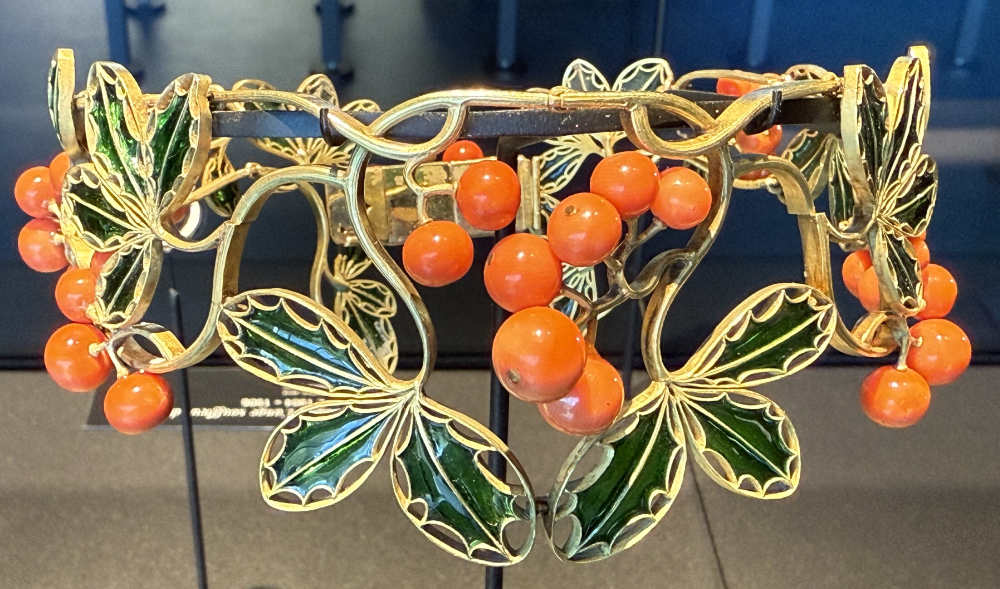Lalique and numismatics
She was the golden voice, the divine, the admired diva of her time. Everyone who loved the theatre was at her feet: Sarah Bernhardt, the first international celebrity of show business.
Collaboration with innovative artists
This may also have been due to Sarah Bernhardt’s skills as an actress. But more importantly, she knew how to get people talking about her. World tours, events and close collaboration with the media: Sarah Bernhardt stylised herself into a global star. To achieve this, she worked with talented young artists who staged her performances in a modern way. Her posters were designed by the Czech graphic artist Alfonse Mucha. From 1891 onwards, her stage decorations were created by a relatively unknown jeweller named René Lalique, who had opened a small workshop in 1885.

Valuable jewellery does not have to be made of gold
Lalique offered Bernhardt a decisive advantage: he did not rely on precious materials. Instead, he designed his unique pieces using inexpensive materials that had previously rarely been used in traditional jewellery making. Lalique used horn, semi-precious stones, glass, ivory and enamel – always the material that had exactly the right texture and colour for the intended purpose. This was ideal for the stage. The large, impressive pieces of jewellery were effective from a distance without costing a fortune.
This was Lalique’s breakthrough. In 1890, he opened his own shop in Paris – in a prime location. From there, Lalique conquered the world with his jewellery and perfume bottles.

The 1896 medal
In 1896, the year Lalique created this medal, he had not yet quite made his breakthrough. Perhaps that is why he accepted the commission, which was actually a little beyond his capabilities. Lalique was known for his designs. He was certainly not a medallist, as can be seen from the medal.
It was created for the Journée Sarah Bernhardt on 9 December 1896. This was a kind of brunch at the Grand Hôtel in Paris – now the Intercontinental Paris Le Grand – with a multi-course menu. The menu (salmon trout / cutlet / goose liver pâté / pheasant / ice cream cake) has been preserved in minute detail because Alfonse Mucha created the menu. The importance Mucha attached to the event is shown by the fact that he did not ask for any money for his design, but only for three tickets to the event. After the meal, the party moved on to the Théâtre de la Renaissance, where the actress performed a kind of ‘best of’ her stage successes. These included excerpts from Racine’s Phèdre and Voltaire’s Rome sauvée.
As a souvenir for the participants, René Lalique created a medal that is more reminiscent of a piece of jewellery than a numismatic object. It has a hole at the top so that it can be worn on a chain. It was cast in such a way that its blank is more reminiscent of a Stephanephoric tetradrachm from the Hellenistic period than a contemporary minted medal. There was space on the back of the medal for a personalised engraving. On our example, for example, one can read: à Sully pour l’heureux souvenir reconnaissant de la journée du 9 décembre 1896 Sarah Bernhardt (= for Sully, in grateful memory of the day of 9 December 1896 Sarah Bernhardt). Incidentally, we can identify this Sully. Jean Mounet-Sully was a fellow actor and, for a short time, also Bernhardt’s lover.
This numismatic rarity was sold for €4,900 at an online auction held by iNumis on 5 December 2018. That is actually quite reasonable when you consider that this price would only buy you one of the smaller, newly created vases from the luxury brand Lalique.
Lalique: A modern luxury brand
Because Lalique still exists today. In Wingen-sur-Moder, glass artists produce innovative objects that fetch top prices. However, jewellery is hardly ever included. Even Lalique’s only modern medal has not yet made it into the auction world: in 1982, Lalique created the Olympic medals for Albertville.
Calouste Gulbenkian: coin collector and collector of Lalique
Incidentally, there is another connection between Lalique and numismatics. The famous coin collector Calouste Gulbenkian, like Sarah Bernhardt, appreciated the beauty of Lalique’s jewellery. That is why the Gulbenkian Museum in Lisbon not only houses the most beautiful Greek coins, but also wonderful jewellery by René Lalique. One of the great works of art, the dragonfly pectoral, was even worn by Bernhardt – on loan.
Text and images: Ursula Kampmann

